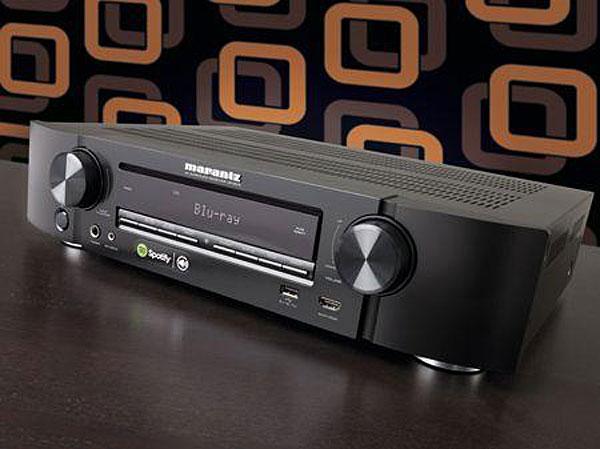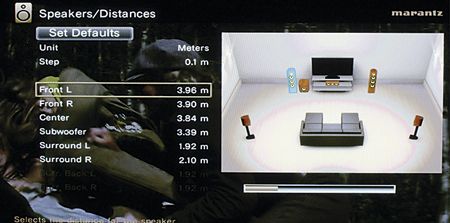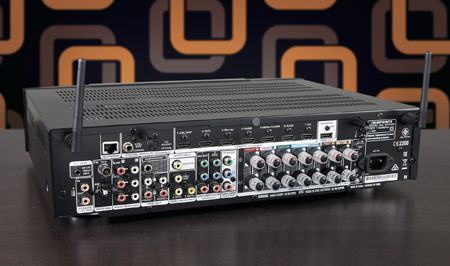Marantz NR1605 review - exclusive

 The Marantz NR1605 is the latest update to the brand's increasingly popular slimline AVR line. With sales of traditional home cinema receivers shrinking faster than the crown jewels of a skinny-dipping Inuit, AV brands have been looking for ways to curry favour with disenchanted cinemaniacs. One solution is to add Wi-Fi and Bluetooth, the other is to embrace a leaner form factor. Here Marantz has done both.
The Marantz NR1605 is the latest update to the brand's increasingly popular slimline AVR line. With sales of traditional home cinema receivers shrinking faster than the crown jewels of a skinny-dipping Inuit, AV brands have been looking for ways to curry favour with disenchanted cinemaniacs. One solution is to add Wi-Fi and Bluetooth, the other is to embrace a leaner form factor. Here Marantz has done both.
A cursory glance might suggest there’s not much else to separate the Marantz NR1605 model from its NR1604 predecessor. The chubby-cheeked cosmetics seem unchanged, matching other separates from the brand. But there are now seven rear-facing HDMI inputs (plus the additional convenience of an HDMI on the front), so kit builders should be satisfied. There’s still only one HDMI output, though. The rear also offers two component inputs, three composite video inputs and a trio of stereo connectors plus single optical/coaxial digital inputs. There are stereo pre-outs for both a second zone and the main stereo pair. A front fascia USB can be used to stream music files from any connected drive.
The receiver now supports 4K 60Hz HDMI 2.0 passthrough via those rear HDMIs, anticipating a time when you’ll actually have a 2160p source, and offers 4K upscaling (to 30Hz) should you not trust your screen to do the job for you. Providing the silicon muscle for this is the new ADV8005 NatureVue video signal processor from Analog Devices. This optimistically includes 4:4:4 colour space support. The receiver does not, however, have HDCP 2.2 copy protection.
Other connections include Ethernet and M-Xport accessory dock with 6v power output. Speaker binding posts are chunky, and there’s a pre-out for the front left/rights. System integrators can take advantage of the 12V trigger output. If you don’t need a 7-channel speaker configuration, you can opt to run 5.1 in a main room and stereo to a second zone, or bi-amp your main stereo pair.
Of course, the biggest difference from last season’s model is the provision of integrated Wi-Fi and Bluetooth, which manifests itself in the form of dual pop up aerials. In truth these erections rather compromise the traditional receiver aesthetic, but you may get away with keeping the aerials recessed. That said, the Marantz 1605’s Wi-Fi doesn’t see 5GHz networks, only 2.4GHz.
The system’s user interface is slicker than an otter’s pocket. From the outset, the NR1605 guides you through configuration, gently prompting speaker set up and sources, as well as Audyssey calibration, which comes MultEQ flavoured. This requires multiple position measurements to calibrate levels, distances and related settings. While a cardboard microphone stand contraption is flatpacked, you’ll be better offer using a camera tripod if you have one (the microphone has a standard tripod bush), as you can measure at exactly the right height for your seating.

I’m slowly warming to the versatility of MultEQ. Here the main Reference setting does a solid job, although I found defeating it altogether can result in a rather fuller and occasionally more exciting sound.
James McAvoy's opening monologue to Filth (Blu-ray) provides a useful comparator. With Audyssey MultEQ off, McAvoy appears to be standing closer to the mic, with MultEQ engaged he physically moves back, his diction seemingly becoming a little clearer.
When the pirate skips make their first approach on Captain Philips (Blu-ray), Henry Jackman’s score picks up tempo, pitter-pattering across the front soundstage. With Audyssey MultEQ on Reference setting, the sea spray is wide, the voices of would-be assailants fighting to be heard in the mix. Turn MultEQ to Flat, where sound calibration is optimised for a slightly smaller listening room, and the mix is better behaved, almost clinically clear. Turn MultEQ off altogether and the action becomes a good deal heavier, and the seas suitably rougher. Switching to MultEQ Left/Right Bypass, the soundstage retains weight in the stereo pair, though central dialogue remains crisp. Some might consider this a good compromise.
During playback, a helpful Info button pulls up a snapshot diagnostic, showing source, sound mode, signal format (FLAC etc), Audyssey mode and active speaker map.

While the NR1605 won’t blow the bloody doors off, it does seem a tad more dynamic than its predecessor. The AVR’s powerplant, still rated at 50W into 8ohms, is deceptively agile. As Vin Diesel races through the gears at the start of Fast & Furious 6 (Blu-ray), the NR1605 has no problem keeping pace and accelerating hard.
Network functionality ticks the right boxes. The model is AirPlay compliant, supports Spotify Connect, and has internet radio services registered. The latter are divided into genres and location, as is the norm. I can’t help feeling a filter for bitrates wouldn’t go amiss though.
File support is broad, with the receiver playing AIFF, MP3, FLAC 192KHz, AAC, ALAC and WMA from a network NAS. DSD (2.8MHz) plays with extreme clarity from a connected USB drive, but Double DSD isn’t recognised.
Overall usability is good. HDMI passthrough means you’ll not need to induct reluctant family members into the home cinema system guru club, just so that they can operate their set-top box of choice. Passthrough can be set to last input chosen or a specific default. Menus are responsive and the user interface intuitive. There’s an auto standby mode which turns the AVR off when it’s not being used. The bundled remote comes with backlit buttons, another nice touch for cinema use.
It goes without saying that the NR1605 will handle all current, popular surround formats, including DTS-HD Master Audio and the Dolby TrueHD family. While it’s not Atmos capable, you can apply Dolby Pro-Logic IIz if you prefer front height speakers to rear backs.
Wi-Fi functionality works well. The receiver didn’t drop a connection during our audition, although it did need to be reconfigured after a software update. Given the option though, I would still always choose to use Ethernet for networking.
There are no swathes of DSP to contend with. Audio presets are limited to Movie, Music and Games modes, with all-channel stereo, Dolby PLII, DTS Neo 6: Music and Virtual options; all have various traits. If nothing appeals there's always Direct. Multiroom playback can be governed by a universal All Zone Stereo mode.
This Marantz proves to be an enjoyable high-res listen. Lenny Kravitz’s fist-pumping Are You Gonna Go My Way (Pure Audio Blu-ray), in 24-bit/192kHz, is delivered with acidic licks that'll test the mettle of any speakers. The receiver also copes surprisingly well with a complex classical DSD download from 2L.
A spin of Ministry of Sound's Anthems 90s CD, delivered via a Musical Fidelity V90 DAC, also reveals this AVR to be a plate-eyed party animal. The deep, recursive beat and centre-locked dialogue of Pump Up The Jam (Techtronic featuring Fell), is infectious. Processed via the Multichannel Stereo mode, your joint will soon be jumping. The AVR’s Virtual surround mode is similarly fun, although both Pro Logic and DTS music processing seemingly have no sense of rhythm.
Overall, this update to Marantz’s NR line is entirely successful. There’s seemingly no overt sonic penalty incurred by building in the wireless radio, and the enhanced feature spread and connectivity options make this an easy receiver to live with. Capable of an energetic multichannel performance, dynamic stereo and decent streaming functionality, this AV receiver is a real-world star. I rate it the best Marantz NR release yet.
Specification
Dolby TrueHD: Yes
DTS-HD Master Audio: Yes
THX: No
Multichannel input: No
Multichannel output (claimed): 7 x 50W
Multiroom: Yes. Second-zone audio
AV inputs: 3 x composite; 3 x analogue stereo, 2 x digital audio (one optical, one coaxial)
HDMI: 7(+1)-in, 1-out, v2.0/v1.4
Video upscaling: To 4K
Component video: 2-in, 1-out
Dimensions: 440(w) x 106(h) x 376(d) mm
Weight: 8.6kg
Also featuring: Audyssey MultiEQ with Dynamic Volume/DynamicEQ; Spotify Connect; internet radio; FM tuner; DLNA media streaming; AirPlay; Bluetooth; AIFF, MP3, FLAC, AAC, ALAC, DSD and WMA file support; Movie, Music, Game and All-Channel Stereo modes
 |
Home Cinema Choice #351 is on sale now, featuring: Samsung S95D flagship OLED TV; Ascendo loudspeakers; Pioneer VSA-LX805 AV receiver; UST projector roundup; 2024’s summer movies; Conan 4K; and more
|






















































